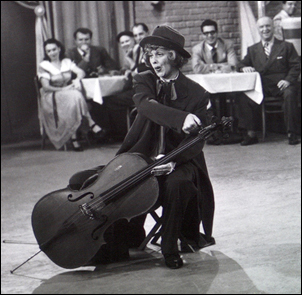(Previous Episodes: 1. Bach at McDonald's. 2. Bach's Invisible Cello. 3. A Cellist, a Pianist, and a Composer Enter a Bar. 4. Bach, Dead and Reborn.)
The confusion we make between illusion and reality affects every last little bit of our daily existence.
We create mystical beings in our imagination, and we assign them an objective, material reality. Among these beings are our teachers, our parents, our siblings, our friends—in fact, every person in our lives. It’s hard to crack this illusion, but “my cello teacher,” for instance, was in truth “my perception of my cello teacher,” rather than a tangible being with recognizable material properties. These days “my perception of my cello teacher” has become “my memory of my perception of my cello teacher,” taking the teacher further into the realm of the illusory.
If you think Bach exists for real, you risk assigning him a sort of ultimate authority; Bach would have “the last word” as concerns his music. And you risk assigning many other people minor-deity status, with everyone conspiring to pass judgments and create constraints—Fournier, Bazelaire, Casals, Starker, Bijlsma, Rostropovich, Ma, and a thousand teachers, players, writers, listeners, family, and friends.
To give an example, when I told my cello teacher back when I was 14 that I wanted to become a professional musician, she said to me, with some sadness in her voice, “But you’ll never be a Pierre Fournier.”
Realistically, I think she was telling me that I wasn’t very good and wasn’t going to become very good either. Pierre Fournier, the blessed high priest, was a herald of the sacred texts of the fountainhead Johann Sebastian Bach. And I, unsightly adolescent, was unworthy of the priesthood. I should become an accountant, maybe. Or a mass murderer.
For a long time I struggled with the high priests inside my head, telling me that “my Bach” wasn’t “as good as Fournier’s” (or Casals’s or— whatever, whomever). I’d play Bach in my practice room, and the voices of the high priests moaned with pain about my intonation, my technique, my articulations, my haircut, you name it.
Then one day I became simple-minded, as it were. I asked myself an innocent little question. How would I play if I just decided to enjoy my own intimate relationship with the ambiguous blueprint, with all that “Bach-related information” that had come my way over the decades? How about I stop chasing Fournier’s ghost, and start chasing Bach’s ghost instead?
I went there. I ignored the musicologists, the cellists and non-cellists whom I’ve heard play over the years, my old teacher’s warnings, professional standards of technique, social standards of decency. I decided on my tempi, my dynamics, my bow strokes, my rubato, my everything. And I finally played “The Six Suites by Pedro de Alcantara and J. S. Bach,” in full ownership of my subjective half of the deal.
Did I play well? Such a question implies objective standards that point toward a thing called “reality.” Fournier probably wouldn’t have thought that I played well, but as it happens Fournier is also dead. His standards don’t count.
Did I enjoy myself? I was as happy as a barefoot three-year-old in a sandbox, playing without adult supervision. In my subjective perception I build castles, palaces, and entire cities using Bach’s blueprints, or what was left of these blueprints “after the earthquake.” I mean, the earthquake of reality and illusion clashing for supremacy.
In conclusion & in a few words: Bury reality in the sandbox and play with your illusions. No, no, sorry! Bury your illusions in the sandbox and enjoy reality in all its glory.











